Settings page
You can change the general settings of the openSPOT4 on this page.
Configuration profile
The openSPOT4 stores all its configuration in individual profiles. There are 10 of them in the openSPOT4 Pro, 5 in the openSPOT4, and profile #1 is active by default. Initially all configuration profiles have the factory default settings.
There are multiple methods to switch between configuration profiles:
- Using the dropdown list at the bottom left of the web interface
- Using the Settings page
- Using your transceiver (see the Control calls section for more information)
- Using the buttons (see the Button usage section for more information).

You can rename profiles, copy one to another slot or export/import to/from a file.
By setting the Change after last call setting to non-zero (this setting is available if Advanced mode is enabled), the openSPOT4 will switch to the specified profile slot after a timeout since the last call was received.
If the Always use profile #1 on power on setting is enabled, then the profile #1 will always be loaded when powering on the device.
Notes on configuration profiles
- Please keep in mind that all configuration profiles are empty by default, so if you switch to a previously unused profile, the openSPOT4 will start in Wi-Fi AP mode as there will be no configured Wi-Fi networks to connect.
- The openSPOT4 reboots on profile switch.
- Wi-Fi networks and passwords are stored for each profile separately.
- The web interface password is stored for each profile separately.
Firmware upgrade
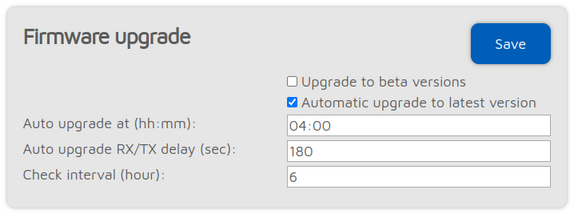
The openSPOT4 will automatically check for firmware upgrades periodically, as specified by the Check interval setting (only available if Advanced mode is enabled). If Automatic upgrade settings are checked then the openSPOT4 will automatically download and apply upgrades.
If a new firmware upgrade is available, downloading and applying the upgrade is automatically scheduled for the (local) time set by the Auto upgrade at setting. By default it's set to 4am next day. The upgrade will only be performed if there were no calls received for at least Auto upgrade RX/TX delay seconds (this setting is only available if Advanced mode is enabled).
Note that the openSPOT4 reverts to the previous firmware version if a reboot happens in 1 minute after the new firmware boots. The new firmware is finalized if the uptime reaches 1 minute.
Voice announcements

The openSPOT4 has a built-in voice announcement system. Some announcements are played locally from the openSPOT4's built-in flash memory, but some are played using our open source voice announcement server.
Modem mode notes:
- DMR: voice announcements are sent to TG9, so to hear them, make sure you have TG9 in your radio's RX group list.
- NXDN®: voice announcements are sent to TG0.
- P25: voice announcements are sent to TG9.
If the battery charge percentage is 15% or below, and the Enable battery low announcement is turned on, then the openSPOT4 transmits battery charge status voice announcements every 5 minutes.
If the Time announcement interval is set, then the openSPOT4 will periodically announce current time. Interval is calculated from midnight, so for example if it is set to every 3 hours, then it will announce current time at 3AM, 6AM, 9AM and so on. Before announcing the time, the openSPOT4 checks if a call came from the network or the modem in the last 10 seconds. If yes, the time announcement will be skipped so it won't interfere with ongoing calls.
If you enable Advanced mode, the following settings will show up:
- You can shorten profile announcements by checking the Shortened profile announcement checkbox.
- If you don't want to hear the linked reflector/talkgroups list, then you can shorten BrandMeister announcements by checking the Shortened BrandMeister announcement checkbox.
- You can disable built-in voice announcements by checking the Use server only checkbox. Note that startup voice announcements played right after the openSPOT4 boots will still be played from the openSPOT4's flash memory.
- You can set your own voice announcement server's host and port.
- Net state announcement int. sets the interval of the announcement if the openSPOT4 can't connect to a Wi-Fi network.
See the Control calls section for more information about Profile query/change base ID, Connector query ID, IP address query ID, Battery status query ID, and Time query ID.
Location settings

Setting location data is optional. It is used by some connectors like the Homebrew/MMDVM® to report the location of the openSPOT4 to the connector's network.
The Fill with GeoIP button queries a GeoIP database to fill the location information based on the current external IP address of the browser.
Latitude and longitude is in decimal degrees. Google Maps will display a location's coordinates in decimal degrees if you click on it:
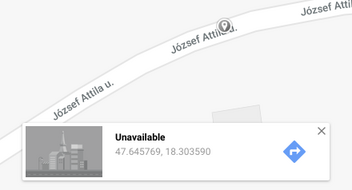
Both height values refer to the height of your openSPOT4 (they are used separately).
DMR settings

The modem will only process DMR calls with a matching Color code.
If the source callsign of a cross mode call has no associated DMR ID, and it can't be parsed into a number, then the Default cross mode source DMR ID will be used for the outgoing DMR call. If you are the only person using the openSPOT4, set this to your DMR ID, and then you don't need to change the callsign of your radio to your DMR ID.
If Advanced mode is enabled, the following settings show up:
In case a DMR network is connected in a non-DMR modem mode, and the Use cross mode destination DMR ID is checked, then calls to the DMR network will be sent to the DMR ID specified at the Cross mode destination DMR ID field, except when using the Homebrew/MMDVM connector (it has a Route cross mode calls to ID field, and it will always be used).
If a call is received by the modem to the Echo ID, then the openSPOT4's built-in local echo service gets activated. It will record the call and plays it back after the call is finished. Both private and group calls are answered with a private echo call reply.
The Preferred talkgroup list decides which talkgroup list to use for resolving talkgroup IDs to their names.
If the Allow only IDs as cross mode callsigns setting is enabled, and the source callsign of a cross mode call has no associated ID in the database, and also it can't be parsed into a DMR ID, then the call will be ignored.
If the Force source ID from modem is set to other than 0, the source DMR ID of all voice calls received by the modem will be replaced with this ID.
If the Send no in-band data to network setting is enabled, then in-band data coming from the modem (like the talker alias or in-band GPS position information) won't be sent to the network.
If the Force talker alias to DMR network is set, then this talker alias will be sent for all calls coming from the modem.
If the Send no in-band data to modem setting is enabled, then the openSPOT4 will remove all in-band data from calls coming from the network. By default this setting is enabled. If you have a radio which supports talker alias decoding (like Hyteras with at least firmware version v8), turn off this setting to let the openSPOT4 pass through in-band data to your radio. If you have a radio which does not support talker alias decoding, turn on this setting to prevent issues with decoding voice calls containing in-band data (voice stuttering, calls dropping etc.).
D-STAR® settings

The Default callsign for cross mode calls will be used when a received DMR or NXDN call does not have a talker alias, or the call's ID doesn't have an associated callsign in the database (or the database is not available).
If Advanced mode is enabled, the following settings show up:
If a call is received by the modem to the Echo callsign, then the openSPOT4's built-in local echo service gets activated. It will record the call and plays it back after the call is finished.
The Dst callsign for cross calls will be used as the destination callsign for calls to the D-STAR transceiver coming from the network.
If the Force source callsign to D-STAR network for cross mode calls is activated, then the source callsign of cross mode calls sent to the D-STAR® server will always be set to the Forced src callsign for cross calls. This is useful for example if you use a C4FM transceiver with a source callsign not exactly the same as your callsign (ex. you've appended your nickname to your callsign), but the server only accept calls with valid callsigns.
If the Force message to D-STAR network in cross mode is not empty, then the specified message will be sent to the D-STAR® network if a DMR, C4FM or NXDN call is received from the modem.
If the Transmit RX confirmation checkbox is checked, the openSPOT4 will transmit a short call confirmation after the PTT is released on the D-STAR® radio.
If the Auto mute DTMF commands checkbox is checked and a call is ongoing from the modem, and a DTMF sequence is being entered, then the call to the network will be automatically ended, so others won't be annoyed by hearing your DTMF tones on the same reflector/gateway.
If the Ignore DTMF commands after 10 secs checkbox is checked, then all DTMF commands will be ignored after 10 seconds have elapsed since call start. This is useful to avoid any mistakenly entered and decoded DTMF commands.
C4FM/Fusion® settings

The Default callsign for cross mode calls will be used when a received DMR or NXDN call does not have a talker alias, or the call's ID doesn't have an associated callsign in the database (or the database is not available).
If Advanced mode is enabled, the following settings show up:
- Allow data calls to network: if enabled, data calls will be forwarded from the modem to the network. This is not required for normal operation.
- Ignore Wires-X® button commands: Wires-X® button commands received by the modem will be ignored in case this settings is enabled.
- Don't convert Wires-X® server names to uppercase: all server names sent to the transceiver are converted to uppercase by default, and space characters are replaced with dashes. This conversion can be turned off with this setting. The conversion is done because some radios (like the Yaesu FT70) do not show lowercase characters on their displays, and space characters prevent the radio from saving the current server to a category.
- Don't send downlink callsign to modem: the openSPOT4 sends call related information like active connector, TG/server ID as the downlink callsign, so the transceiver can display this during an ongoing call, or in the RX confirmation. This function can be disabled with this setting, which is useful if you want to use the openSPOT4 as a gateway between C4FM networks, to prevent it from modifying the call stream.
- Don't send automatic Wires-X® connect messages: the openSPOT4 automatically sends Wires-X® connect messages in case it connects or disconnects to/from a server. These automatic messages can be disabled with this setting.
- Hide profiles in Wires-X® "all" reply: if this setting is enabled, configuration profiles won't be listed on the first page for a Wires-X® "all" server search.
- Auto mute DTMF commands: if a call is ongoing from the modem, and a DTMF sequence is being entered, and the first character is a Special command / cross mode private call or Cross mode group call DTMF code, the outgoing call to the network will be automatically ended, so others won't be annoyed by hearing your DTMF tones on the same reflector/talkgroup.
- Ignore DTMF commands after 10 secs: if this checkbox is checked, then all DTMF commands will be ignored after 10 seconds have elapsed since call start. This is useful to avoid any mistakenly entered and decoded DTMF commands.
- Special command/cross mode private call DTMF code: this code is used as the first character for entering a control DTMF code, or starting a private call in cross modes. See more info at each connector's description, or at the Control calls section.
- Cross mode group call DTMF code: if a connector is active which supports group calls and C4FM cross mode, then this code can be used to start group calls to the ID entered after this code.
- If Transmit RX confirmation is checked, then the openSPOT4 will transmit a short call confirmation after the PTT is released on the C4FM radio.
- If a call is received by the modem to the Echo DGID, then the openSPOT4's built-in local echo service gets activated. It will record the call and plays it back after the call is finished.
- If the Only receive DGID from modem checkbox is checked, then calls only to the specified DGID from modem will be processed by the modem.
- If the Replace DGID to modem enabled checkbox is checked, then the DGID in all frames received from the network will be replaced with the specified Replace DGID to modem value.
- If the Replace DGID to net enabled checkbox is checked, then the DGID in all frames received from the modem will be replaced with the specified Replace DGID to net value.
- The Cross mode DGID to net setting specifies the DGID to use in cross mode calls sent to the network. Some servers change linked rooms depending on this value.
NXDN® settings

- The modem will only process NXDN® calls with a matching Radio Access Number if it is set other than 0.
If a call is coming from a mode which does not have ID information (ex. C4FM), or the source ID is outside the NXDN® ID range (0-65535), then the Default cross mode source ID will be used as the source ID for the call. This ID will always be used if the Always use this ID in cross mode checkbox is checked.
If you use a non-NXDN® network with your NXDN® radio, you can set this to your NXDN® ID.
If Advanced mode is enabled, the following settings show up:
- If a call is received by the modem to the Echo ID, then the openSPOT4's built-in local echo service gets activated. It will record the call and plays it back after the call is finished. Both private and group calls are answered with a private echo call reply.
- If a call is coming from a mode which does not have ID information (ex. C4FM), or the destination ID is outside the NXDN® ID range (0-65535), then the Default cross mode destination ID will be used as the destination ID for the call. This ID will always be used if the Always use this ID in cross mode checkbox is checked.
- If the Allow only IDs as cross mode callsigns setting is enabled, and the source callsign of a cross mode call has no associated ID in the database, and also it can't be parsed into an NXDN® ID, then the call will be ignored.
P25 settings

The modem will only process P25 calls with a matching Network Access Code (NAC). Note that the openSPOT4 requires the NAC in decimal format (example: if you have the NAC 0x293 in your radio then you have to enter 659 in the openSPOT4).
If the source callsign of a cross mode call has no associated DMR/P25/CCS7 ID, and it can't be parsed into a number, then the Default cross mode source P25 ID will be used for the outgoing P25 call. If you are the only person using the openSPOT4, set this to your DMR/P25/CCS7 ID, and then you don't need to change the callsign of your radio to your DMR/P25/CCS7 ID.
If Advanced mode is enabled, the following settings show up:
If a call is received by the modem to the Echo ID, then the openSPOT4's built-in local echo service gets activated. It will record the call and plays it back after the call is finished. Both private and group calls are answered with a private echo call reply.
If the Allow only IDs as cross mode callsigns setting is enabled, and the source callsign of a cross mode call has no associated ID in the database, and also it can't be parsed into a DMR/P25/CCS7 ID, then the call will be ignored.
POCSAG settings
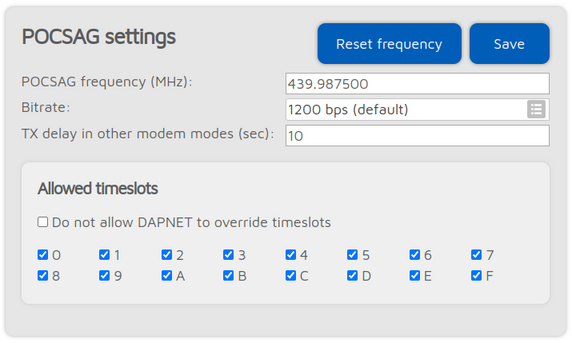
This section is only available if Advanced mode is enabled.
If the modem is transmitting POCSAG messages then it will switch to the POCSAG frequency. The TX delay in other modem modes setting specifies how many seconds the openSPOT4 should wait after the last call has been finished to switch to POCSAG mode and start transmitting the queued messages.
There are 16 timeslots for POCSAG, these timeslot settings can be overridden by the DAPNET server when the DAPNET connector is connected unless the Do not allow DAPNET to override timeslots checkbox is checked. Each timeslot is 6.4 seconds long. The openSPOT4 will only start transmitting POCSAG messages if the current timeslot is allowed.
Transcode gain settings (openSPOT4 Pro only)
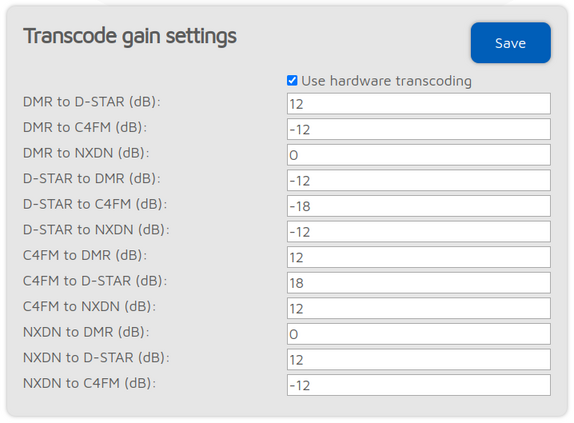
This section is only available if Advanced mode is enabled.
These settings allows you to adjust the gain used during transcoding to correct the volume difference between systems.
If the Use hardware transcoding checkbox is unchecked, then the openSPOT4 Pro will use the software based transcoder, like the openSPOT4. Call audio playback on the web interface and D-STAR cross mode will not work in this case.
Note that as the standard (non-Pro) version of the openSPOT4 has no onboard transcoding hardware, it can't change the audio level of the transcoded stream. This may cause you to hear others loudly, but others hear you quietly, or vice-versa.
Lock settings

This section is only available if Advanced mode is enabled.
These settings allows you to lock the openSPOT4 to the given IDs and/or callsigns. If lock is enabled, the openSPOT4's modem will only allow calls originating from the given IDs or callsigns.
Call mute settings
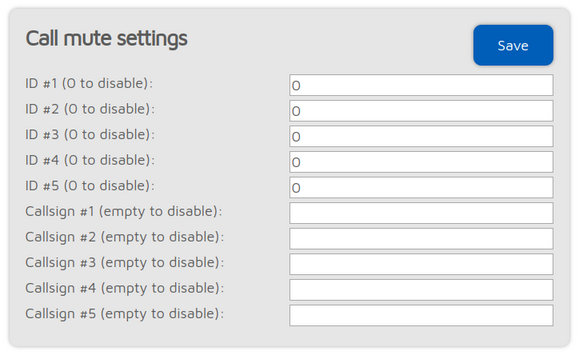
This section is only available if Advanced mode is enabled.
These settings allows you to mute calls coming from the given IDs and/or callsigns (both coming from the network and the modem). Calls from muted IDs/callsigns will still be transmitted, but with silent audio.
Beeper settings
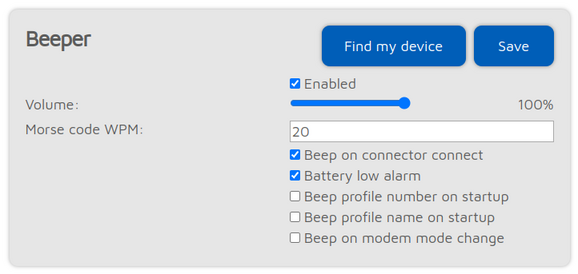
This section is only available if Advanced mode is enabled.
If the Beep profile number on startup setting is enabled, then the openSPOT4 will beep the letter P followed by the currently active profile number on startup in Morse code. If the Beep profile number on startup setting is enabled, then the profile's name will also be played in Morse code.
If the Beep on modem mode change setting is enabled, then the openSPOT4 will beep the modem mode's name in Morse code when it is changed.
Call audio settings (openSPOT4 Pro only)

If the Do not play audio from modem setting is enabled, and call audio playback is enabled on the Status page, then audio of calls received by the modem won't be played. This is useful if you use the web interface to listen to call audio, and you want to answer calls using your transceiver.
RTC settings
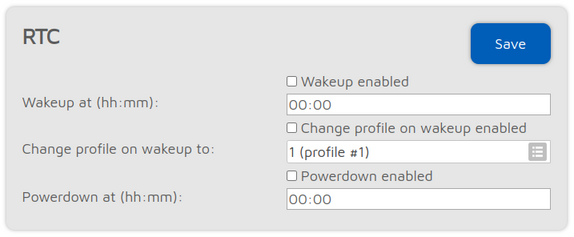
This section is only available if Advanced mode is enabled.
You can set a daily wakeup and a powerdown time here. You can also set the profile to boot when waking up, so it's possible to jump between configuration profiles.
Miscellaneous settings

You can enable Dark mode here.
Enabling the Power off if no charger is connected setting is useful if the openSPOT4 is installed in a vehicle, as the device will follow the USB power status (it will turn off if USB power is lost and it will turn on if USB power is restored). The Power off delay setting delays powering off if USB power is lost. This is useful for example if you want to keep using the openSPOT4 for a few minutes after you've stopped the car.
If the Disable fast battery charging setting is enabled, then the battery is charged with a lower current. Note that fast charging is only active if the openSPOT4 is turned off while it is connected to a charger with enough input current. It's recommended to use a charger which can supply at least 1500mA.
Checking the Disable callsign-ID database queries setting is useful if the openSPOT4 is used in a network where internet access is disabled. This prevents the openSPOT4 from trying to get a callsign for an ID or vice versa from the SharkRF callsign-ID database.
If the Unlink when power button pressed 3 times setting is enabled (this is only visible if Advanced mode is enabled), and the power button is pressed 3 times quickly, then the openSPOT4 will do the following instead of beeping the currently active profile number and name in morse code:
- If the Homebrew/MMDVM® connector connector is active, then a quick call will be started to TG4000 to make the server unlink any linked dynamic talkgroups, and if the connector is connected using the Homebrew protocol, then a call interrupt command will also be sent to break any ongoing calls
- In case any other connector is active, the Null connector will be activated
You can also set the Status LED brightness with the slider. The new brightness setting will be only applied at the next LED state change.

There are also buttons for turning off/rebooting the device or resetting the config profile.